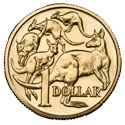AU$
| Australian dollar | |||||
|---|---|---|---|---|---|
| Australian dollar (English) | |||||
|
|||||
| ISO 4217 | |||||
| Code | AUD | ||||
| Number | 036 | ||||
| Exponent | 2 | ||||
| Denominations | |||||
| Subunit | |||||
| 1/100 | cent | ||||
| Symbol | $, A$ or AUD | ||||
| cent | c or ¢ | ||||
| Banknotes | $5, $10, $20, $50, $100 | ||||
| Coins | 5c, 10c, 20c, 50c, $1, $2 | ||||
| Demographics | |||||
| Official user(s) |
7 Australian territories
3 countries
|
||||
| Unofficial user(s) | |||||
| Issuance | |||||
| Central bank | Reserve Bank of Australia | ||||
| Website | www |
||||
| Printer | Note Printing Australia | ||||
| Website | www |
||||
| Mint | Royal Australian Mint | ||||
| Website | www |
||||
| Valuation | |||||
| Inflation | 1.3% (Australia only) (March 2016 Reserve Bank estimate) | ||||
| Source | Reserve Bank of Australia, March 2016. | ||||
| Pegged by | Tuvaluan dollar and Kiribati dollar at par | ||||
The Australian dollar (sign: $; code: AUD) is the currency of the Commonwealth of Australia, including Christmas Island, Cocos (Keeling) Islands, and Norfolk Island, as well as the independent Pacific Island states of Kiribati, Nauru and Tuvalu. Within Australia, it is almost always abbreviated with the dollar sign ($), with A$ or AU$ sometimes used to distinguish it from other dollar-denominated currencies. It is subdivided into 100 cents.
In 2011, the Australian dollar was the fifth most traded currency in the world, accounting for 7.6% of the world's daily share. It trades in the world foreign exchange markets behind the US dollar, the euro, the yen and the pound sterling. The Australian dollar is popular with currency traders, because of the comparatively high interest rates in Australia, the relative freedom of the foreign exchange market from government intervention, the general stability of Australia's economy and political system, and the prevailing view that the Australian dollar offers diversification benefits in a portfolio containing the major world currencies, especially because of its greater exposure to Asian economies and the commodities cycle. The currency is commonly referred to by foreign-exchange traders as the "Aussie dollar".
...
Wikipedia


